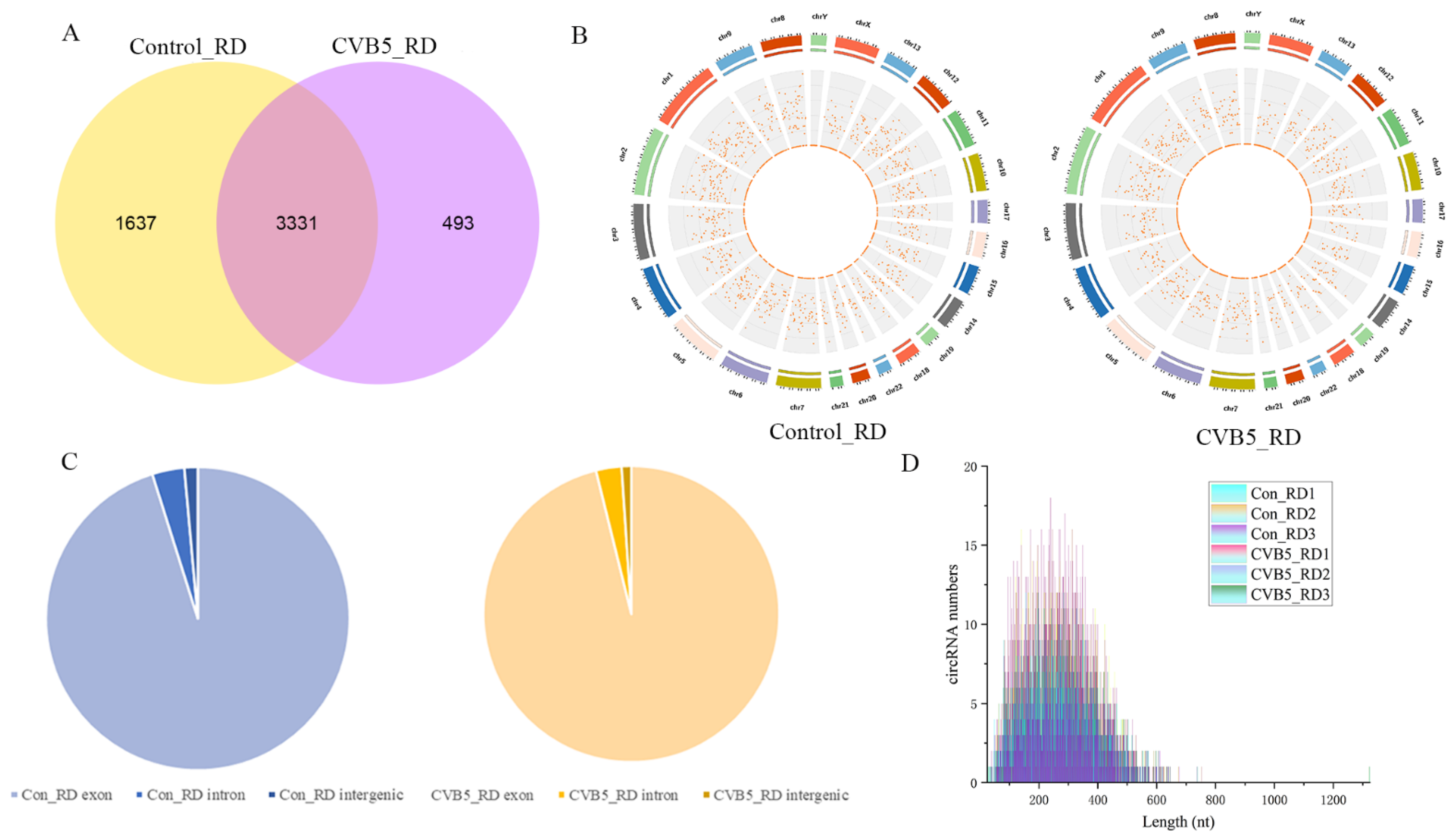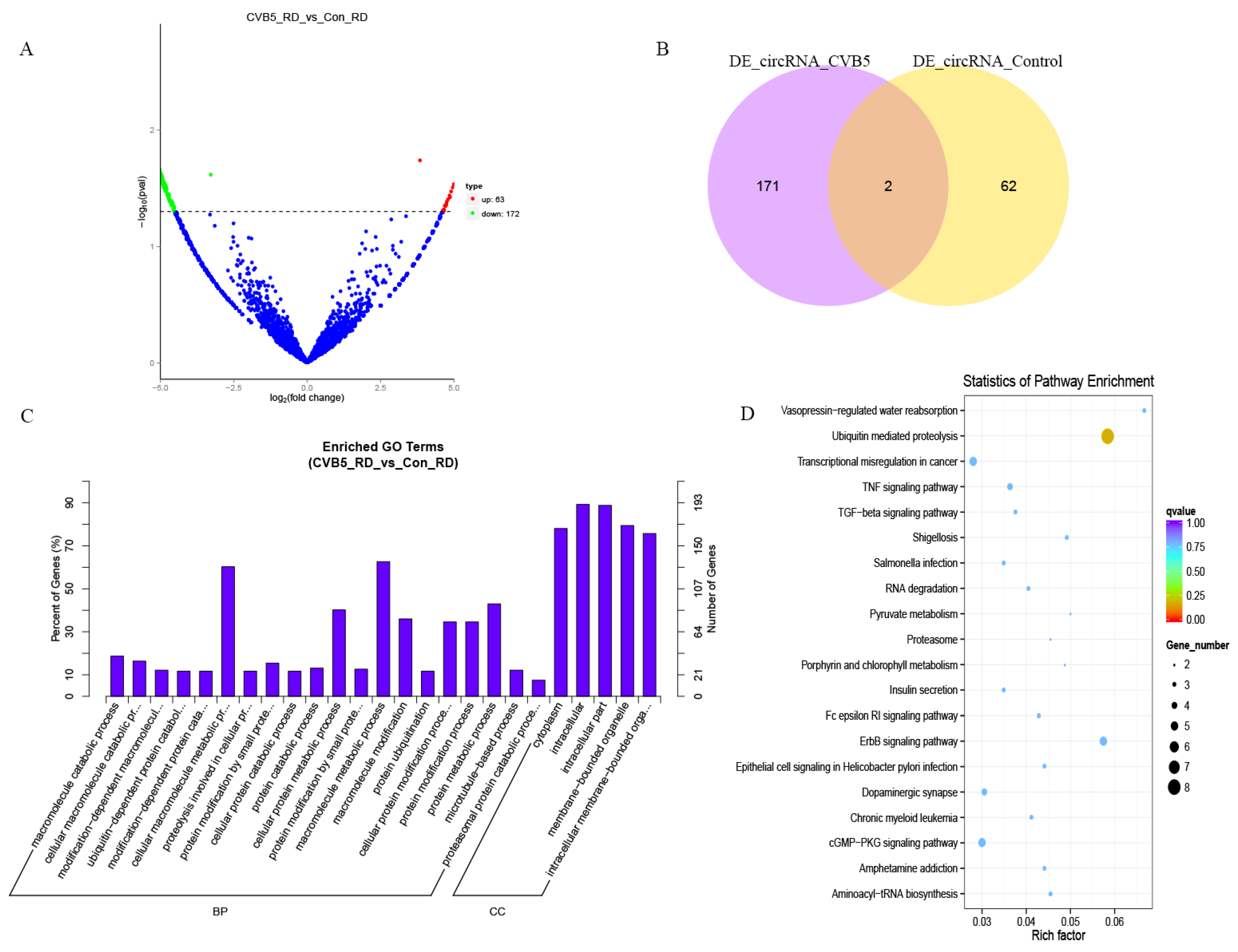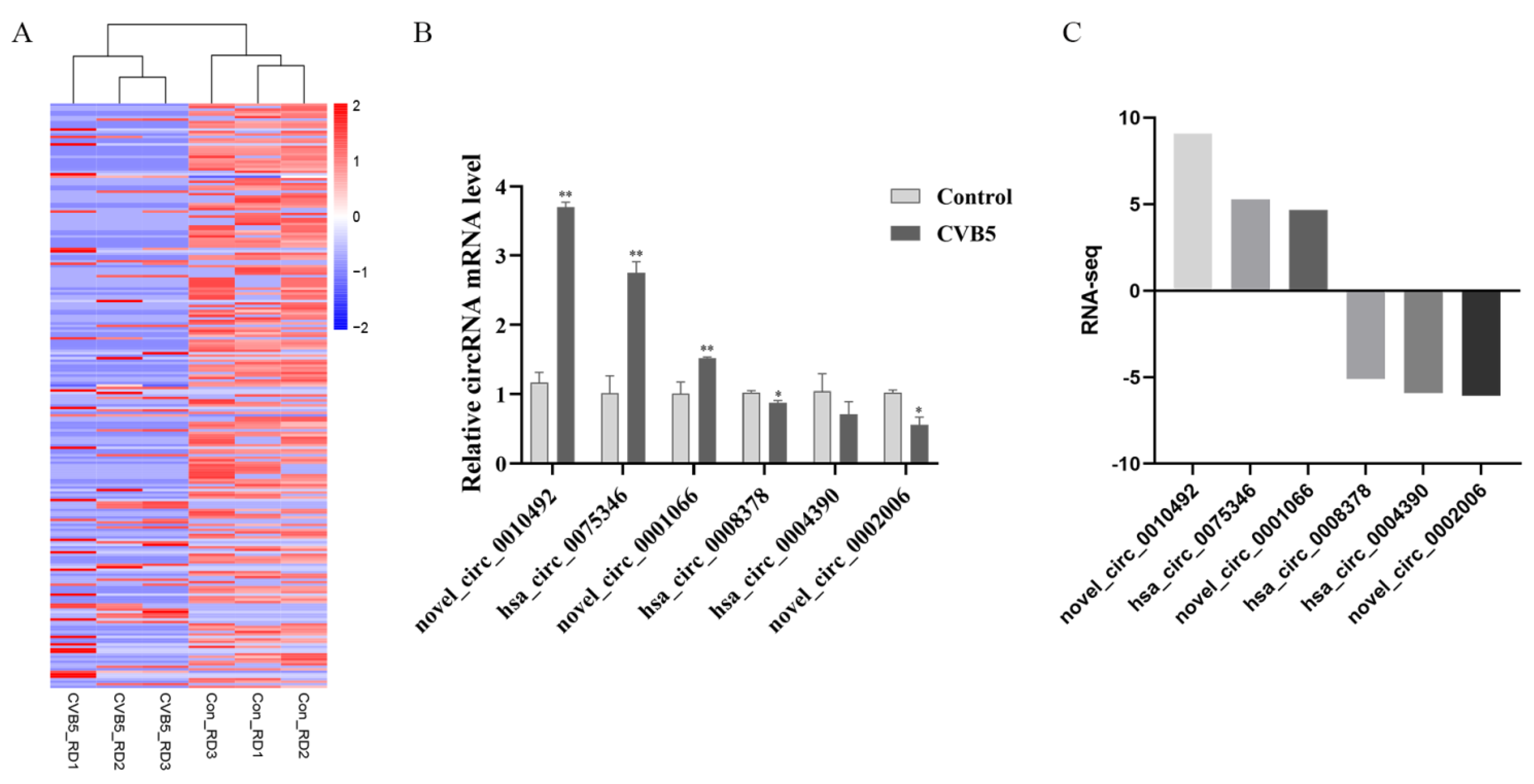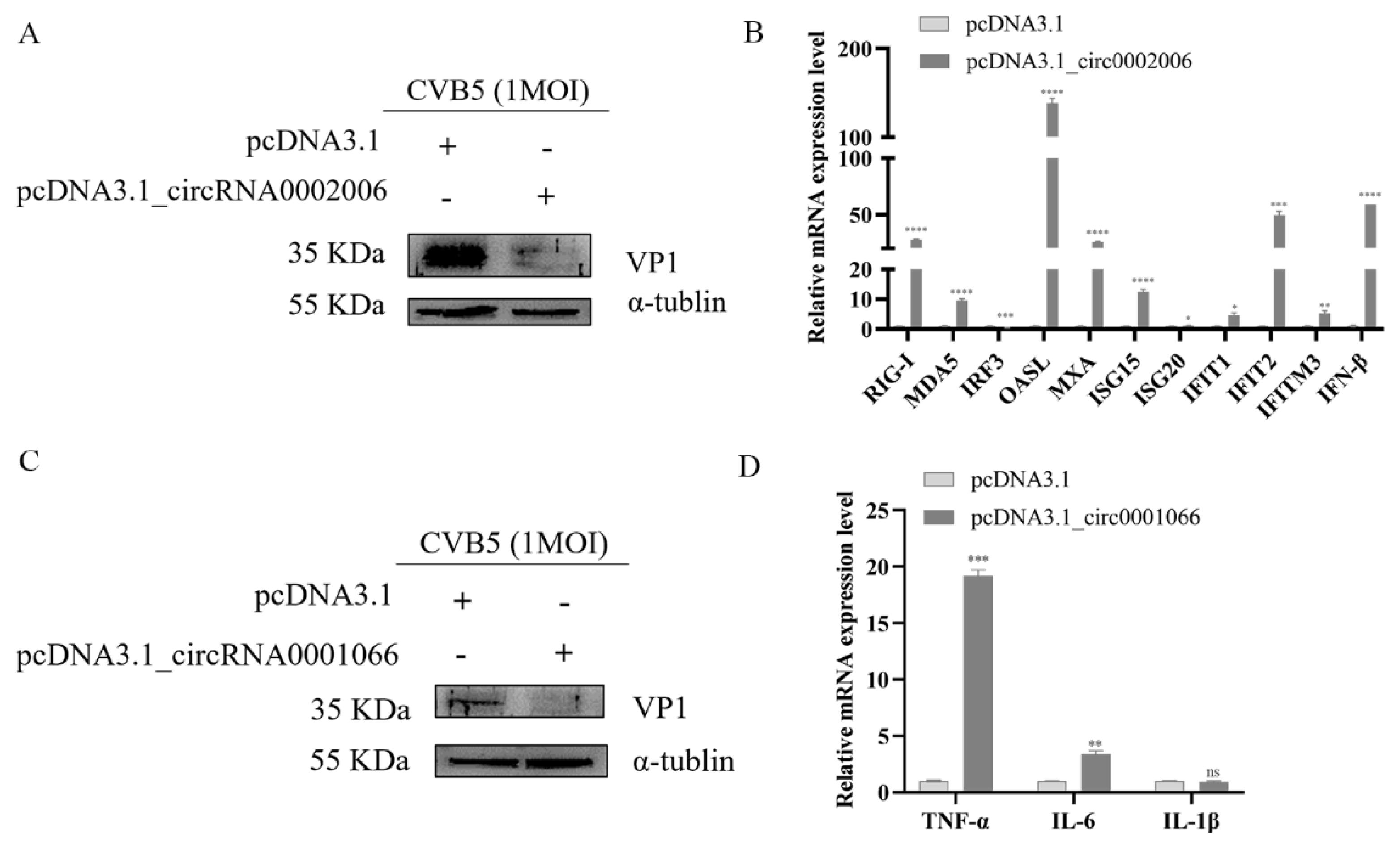Bioinformatics and Screening of a Circular RNA-microRNA-mRNA Regulatory Network Induced by Coxsackievirus Group B5 in Human Rhabdomyosarcoma Cells
Abstract
:1. Introduction
2. Results
2.1. Identification of circRNAs Expression Profiles
2.2. Functional Analysis for Differential Expression of circRNAs
2.3. Validation of Changes in the Differential Expression of circRNAs after CVB5 Infection
2.4. Analysis of a circRNA-miRNA-mRNA Interaction Network
2.5. Potential Treatment Values of novel_circ_0002006 and novel_circ_0001066 in CVB5 Infection
2.6. Verification of miRNA from Immune Interaction Network
3. Discussion
4. Materials and Methods
4.1. Cells, Viruses, and Infection
4.2. RNA Extraction, Sequencing, and the Identification of circRNAs
4.3. Enrichment Analysis of Differentially Expressed circRNAs
4.4. Real-time Quantitative PCR
4.5. Construction of Interaction Network
4.6. CircRNA Plasmid Construction and Transfection
4.7. Western Blotting Analysis
4.8. Statistical Analyses
5. Conclusions
Supplementary Materials
Author Contributions
Funding
Institutional Review Board Statement
Informed Consent Statement
Data Availability Statement
Conflicts of Interest
References
- Tapparel, C.; Siegrist, F.; Petty, T.J.; Kaiser, L. Picornavirus and enterovirus diversity with associated human diseases. Infect. Genet. Evol. 2013, 14, 282–293. [Google Scholar] [CrossRef] [PubMed]
- Du, Z.; Zhao, Y.; Luo, Y.; Du, L.; Gan, Q.; Zhang, H.; Li, J.; Yang, Z.; Ma, S. Ongoing change of severe hand, foot, and mouth disease pathogens in Yunnan, China, 2012 to 2016. J. Med. Virol. 2019, 91, 881–885. [Google Scholar] [CrossRef] [PubMed]
- Li, W.; Li, C.; Liu, L.; Liu, X.; Shang, S.; Mao, H.; Zhang, Y. Molecular epidemiology of enterovirus from children with herpangina or hand, foot, and mouth disease in Hangzhou, 2016. Arch. Virol. 2019, 164, 2565–2571. [Google Scholar] [CrossRef] [PubMed]
- Aswathyraj, S.; Arunkumar, G.; Alidjinou, E.K.; Hober, D. Hand, foot and mouth disease (HFMD): Emerging epidemiology and the need for a vaccine strategy. Med. Microbiol. Immunol. 2016, 205, 397–407. [Google Scholar] [CrossRef]
- Huang, B.; Harrower, B.; Burtonclay, P.; Constantino, T.; Warrilow, D. Genome Sequences of Coxsackievirus B5 Isolates from Two Children with Meningitis in Australia. Genome Announc. 2017, 5, e01125-17. [Google Scholar] [CrossRef] [Green Version]
- Liu, N.; Jia, L.; Yin, J.; Wu, Z.; Wang, Z.; Li, P.; Hao, R.; Wang, L.; Wang, Y.; Qiu, S.; et al. An outbreak of aseptic meningitis caused by a distinct lineage of coxsackievirus B5 in China. Int. J. Infect. Dis. 2014, 23, 101–104. [Google Scholar] [CrossRef] [Green Version]
- Wang, M.; Yu, F.; Wu, W.; Zhang, Y.; Chang, W.; Ponnusamy, M.; Wang, K.; Li, P. Circular RNAs: A novel type of non-coding RNA and their potential implications in antiviral immunity. Int. J. Biol. Sci. 2017, 13, 1497–1506. [Google Scholar] [CrossRef] [Green Version]
- Jost, I.; Shalamova, L.A.; Gerresheim, G.K.; Niepmann, M.; Bindereif, A.; Rossbach, O. Functional sequestration of microRNA-122 from Hepatitis C Virus by circular RNA sponges. RNA Biol. 2018, 15, 1032–1039. [Google Scholar] [CrossRef]
- Qu, Z.; Meng, F.; Shi, J.; Deng, G.; Zeng, X.; Ge, J.; Li, Y.; Liu, L.; Chen, P.; Jiang, Y.; et al. A Novel Intronic Circular RNA Antagonizes Influenza Virus by Absorbing a microRNA That Degrades CREBBP and Accelerating IFN-β Production. mBio 2021, 12, e0101721. [Google Scholar] [CrossRef]
- Awan, F.M.; Yang, B.B.; Naz, A.; Hanif, A.; Ikram, A.; Obaid, A.; Malik, A.; Janjua, H.A.; Ali, A.; Sharif, S. The emerging role and significance of circular RNAs in viral infections and antiviral immune responses: Possible implication as theranostic agents. RNA Biol. 2020, 18, 1–15. [Google Scholar] [CrossRef]
- Huang, J.-T.; Chen, J.-N.; Gong, L.-P.; Bi, Y.-H.; Liang, J.; Zhou, L.; He, D.; Shao, C.-K. Identification of virus-encoded circular RNA. Virology 2019, 529, 144–151. [Google Scholar] [CrossRef] [PubMed]
- Wang, M.; Gu, B.; Yao, G.; Li, P.; Wang, K. Circular RNA Expression Profiles and the Pro-tumorigenic Function of CircRNA_10156 in Hepatitis B Virus-Related Liver Cancer. Int. J. Med. Sci. 2020, 17, 1351–1365. [Google Scholar] [CrossRef] [PubMed]
- Xie, H.; Sun, H.; Mu, R.; Li, S.; Li, Y.; Yang, C.; Xu, M.; Duan, X.; Chen, L. The role of circular RNAs in viral infection and related diseases. Virus Res. 2020, 291, 198205. [Google Scholar] [CrossRef] [PubMed]
- Yang, Q.; Li, Y.; Wang, Y.; Qiao, X.; Liu, T.; Wang, H.; Shen, H. The circRNA circSIAE Inhibits Replication of Coxsackie Virus B3 by Targeting miR-331-3p and Thousand and One Amino-Acid Kinase Front. Cell. Infect. Microbiol. 2022, 11, 779919. [Google Scholar] [CrossRef]
- Hu, Y.; Yang, R.; Zhao, W.; Liu, C.; Tan, Y.; Pu, D.; Song, J.; Zhang, Y. circRNA expression patterns and circRNA-miRNA-mRNA networks during CV-A16 infection of SH-SY5Y cells. Arch. Virol. 2021, 166, 3023–3035. [Google Scholar] [CrossRef]
- Hu, Y.; Xu, Y.; Deng, X.; Wang, R.; Li, R.; You, L.; Song, J.; Zhang, Y. Comprehensive analysis of the circRNA expression profile and circRNA-miRNA-mRNA network in the pathogenesis of EV-A71 infection. Virus Res. 2021, 303, 198502. [Google Scholar] [CrossRef]
- Gao, P.; Ma, X.; Yuan, M.; Yi, Y.; Liu, G.; Wen, M.; Jiang, W.; Ji, R.; Zhu, L.; Tang, Z.; et al. E3 ligase Nedd4l promotes antiviral innate immunity by catalyzing K29-linked cysteine ubiquitination of TRAF. Nat. Commun. 2021, 12, 1194. [Google Scholar] [CrossRef]
- Zuo, Y.; Feng, Q.; Jin, L.; Huang, F.; Miao, Y.; Liu, J.; Xu, Y.; Chen, X.; Zhang, H.; Guo, T.; et al. Regulation of the linear ubiquitination of STAT1 controls antiviral interferon signaling. Nat. Commun. 2020, 11, 1146. [Google Scholar] [CrossRef] [Green Version]
- Sandmann, L.; Yurdaydin, C.; Deterding, K.; Heidrich, B.; Hardtke, S.; Lehmann, P.; Bremer, B.; Manns, M.P.; Cornberg, M.; Wedemeyer, H.; et al. HBcrAg Levels Are Associated With Virological Response to Treatment With Interferon in Patients With Hepatitis Delta. Hepatol. Commun. 2021, 6, 480–495. [Google Scholar] [CrossRef]
- Chen, J.; Wei, X.; Wang, X.; Liu, T.; Zhao, Y.; Chen, L.; Luo, Y.; Du, H.; Li, Y.; Liu, T.; et al. TBK1-METTL3 axis facilitates antiviral immunity. Cell Rep. 2022, 38, 110373. [Google Scholar] [CrossRef]
- Li, C.; Zhou, Y.; Chen, X.; Zhang, Y.; Hu, J.; Ren, C.; Ding, J.; Jiang, D.; Li, Y. Porcine TRIM35 positively regulate TRAF3-mediated IFN-β production and inhibit Japanese encephalitis virus replication. Dev. Comp. Immunol. 2021, 127, 104290. [Google Scholar] [CrossRef] [PubMed]
- Wang, S.; Wang, L.; Dou, L.; Guo, J.; Fang, W.; Li, M.; Meng, X.; Man, Y.; Shen, T.; Huang, X.; et al. MicroRNA 152 regulates hepatic glycogenesis by targeting PTEN. FEBS J. 2016, 283, 1935–1946. [Google Scholar] [CrossRef] [PubMed] [Green Version]
- Singh, A.K.; Rooge, S.B.; Varshney, A.; Vasudevan, M.; Kumar, M.; Geffers, R.; Kumar, V.; Sarin, S.K. Identification of miRNAs associated with dendritic cell dysfunction during acute and chronic hepatitis B virus infection. J. Med. Virol. 2020, 93, 3697–3706. [Google Scholar] [CrossRef] [PubMed]
- Shi, J.; Zhang, Y.; Qin, B.; Wang, Y.; Zhu, X. Long non-coding RNA LINC00174 promotes glycolysis and tumor progression by regulating miR-152-3p/SLC2A1 axis in glioma. J. Exp. Clin. Cancer Res. 2019, 38, 395. [Google Scholar] [CrossRef] [PubMed] [Green Version]
- Jing, Y.; Jiang, X.; Lei, L.; Peng, M.; Ren, J.; Xiao, Q.; Tao, Y.; Tao, Y.; Huang, J.; Wang, L.; et al. Mutant NPM1-regulated lncRNA HOTAIRM1 promotes leukemia cell autophagy and proliferation by targeting EGR1 and ULKJ. Exp. Clin. Cancer Res. 2021, 40, 312. [Google Scholar] [CrossRef]
- Li, Y.; Ashraf, U.; Chen, Z.; Zhou, D.; Imran, M.; Ye, J.; Chen, H.; Cao, S. Genome-wide profiling of host-encoded circular RNAs highlights their potential role during the Japanese encephalitis virus-induced neuroinflammatory response. BMC Genom. 2020, 21, 409. [Google Scholar] [CrossRef]
- Wu, J.; Liu, X.; Shao, J.; Zhang, Y.; Lu, R.; Xue, H.; Xu, Y.; Wang, L.; Zhou, H.; Yu, L.; et al. Expression of plasma IFN signaling-related miRNAs during acute SARS-CoV-2 infection and its association with RBD-IgG antibody response. Virol. J. 2021, 18, 244. [Google Scholar] [CrossRef]
- Gao, Y.; Zhang, J.; Zhao, F. Circular RNA identification based on multiple seed matching. Brief. Bioinform. 2017, 19, 803–810. [Google Scholar] [CrossRef]
- Love, M.I.; Huber, W.; Anders, S. Moderated estimation of fold change and dispersion for RNA-seq data with DESeq2. Genome Biol. 2014, 15, 550. [Google Scholar] [CrossRef] [Green Version]
- Yu, G.; Wang, L.-G.; Han, Y.; He, Q.-Y. clusterProfiler: An R Package for Comparing Biological Themes Among Gene Clusters. OMICS J. Integr. Biol. 2012, 16, 284–287. [Google Scholar] [CrossRef]
- Shannon, P.; Markiel, A.; Ozier, O.; Baliga, N.S.; Wang, J.T.; Ramage, D.; Amin, N.; Schwikowski, B.; Ideker, T. Cytoscape: A software environment for integrated models of Biomolecular Interaction Networks. Genome Res. 2003, 13, 2498–2504. [Google Scholar] [CrossRef] [PubMed]






Publisher’s Note: MDPI stays neutral with regard to jurisdictional claims in published maps and institutional affiliations. |
© 2022 by the authors. Licensee MDPI, Basel, Switzerland. This article is an open access article distributed under the terms and conditions of the Creative Commons Attribution (CC BY) license (https://creativecommons.org/licenses/by/4.0/).
Share and Cite
Li, J.; Teng, P.; Yang, F.; Ou, X.; Zhang, J.; Chen, W. Bioinformatics and Screening of a Circular RNA-microRNA-mRNA Regulatory Network Induced by Coxsackievirus Group B5 in Human Rhabdomyosarcoma Cells. Int. J. Mol. Sci. 2022, 23, 4628. https://doi.org/10.3390/ijms23094628
Li J, Teng P, Yang F, Ou X, Zhang J, Chen W. Bioinformatics and Screening of a Circular RNA-microRNA-mRNA Regulatory Network Induced by Coxsackievirus Group B5 in Human Rhabdomyosarcoma Cells. International Journal of Molecular Sciences. 2022; 23(9):4628. https://doi.org/10.3390/ijms23094628
Chicago/Turabian StyleLi, Jing, Peiying Teng, Fan Yang, Xia Ou, Jihong Zhang, and Wei Chen. 2022. "Bioinformatics and Screening of a Circular RNA-microRNA-mRNA Regulatory Network Induced by Coxsackievirus Group B5 in Human Rhabdomyosarcoma Cells" International Journal of Molecular Sciences 23, no. 9: 4628. https://doi.org/10.3390/ijms23094628




